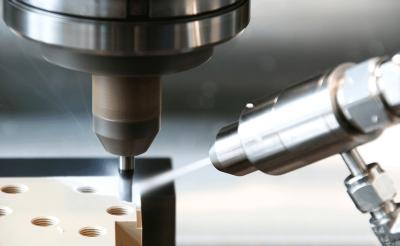
By using CO2 as a process coolant, the cost-efficiency of machining can be significantly improved. With its quattroClean system, acp has developed a solution suitable for use in serial productions. Among other things, it increases productivity by around a third when machining workpieces made from PEEK and aluminum. A further advantage is that components and machines stay much cleaner.
In recent years, the use of CO2 as a coolant for machining processes has become much more popular as an alternative to conventional cooling lubricant concepts. One of the reasons for this is the higher rate of material removal, which increases productivity and also reduces tool wear and the associated downtimes. The so-called cryogenic cooling method with carbon dioxide therefore decreases production costs. With its quattroClean snow jet technology, acp – advanced clean production GmbH offers a cooling system that has proved its worth in serial productions. It can also be integrated into CNC machines and machining centers at a later stage.
The quattroClean system works with liquid carbon dioxide, which is generated as a by-product from chemical processes as well as from the generation of energy from biomass, thus making it environmentally neutral. It is transported at room temperature to the nonwearing circular two-component nozzle. The CO2 only transforms from a liquid to a solid state in the form of fine snow crystals as it leaves the nozzle. The crystals are then bundled by a circular jacketed jet of compressed air and advanced to the process zone at supersonic speed. The temperature of the medium at this point can be as low as 78° C. On the one hand, the patented technology with the jacketed jet ensures a constant pressure and consistently good cooling results. On the other hand, only the quantity of carbon dioxide needed for the desired cooling effect is supplied.
The fact that solid-state carbon dioxide sublimates at room temperature makes this a dry process. Consequently, chips are clean and dry as well as fully recyclable. Dry machining also means that workpieces and machines stay much cleaner. In many cases, there is no further need to clean workpieces after processing. Depending on cleaning requirements, a cleaning module can be integrated quickly and efficiently downstream of the machining process. A further advantage of cooling with CO2 is that parts, for example for medical products, are machined free of contamination. The low temperature also minimizes the risk of a workpiece deforming. Finally, no costs are incurred either for maintenance, care or the disposal of cooling lubricants.
In contrast with other solutions, cooling takes place externally with the quattroClean system rather than through the tool. The non-abrasive and non-toxic jet of snow and compressed air is easy to focus and can be directed exactly where it is needed in the defined process zone around the cutting edge, chips and tool. For this, the CO2 nozzle “travels” with the tool.
Among other applications, the quattroClean system is used in serial productions to lubricate, cool and simultaneously clean machined implants and medical components made from PEEK. Another serial application is in metal processing.
Here, the system is used to cool tools when machining parts made from aluminum. In both cases, productivity could be stepped up by over thirty percent by cooling with CO2 externally using the acp system.
Thanks to its modular concept, the quattroClean system from acp can be easily adapted to customer demands and has a very small footprint. Process parameters, such as the volume flow for compressed air, or the quantity of carbon dioxide required, can be optimally adjusted to the application concerned.
The duration of the jet for both process parameters can also be modified separately. This high degree of flexibility enables the system to be used for completely new applications, as well as for applications which were unsuccessful with standard systems.
Contact Details
Related Glossary Terms
- centers
centers
Cone-shaped pins that support a workpiece by one or two ends during machining. The centers fit into holes drilled in the workpiece ends. Centers that turn with the workpiece are called “live” centers; those that do not are called “dead” centers.
- computer numerical control ( CNC)
computer numerical control ( CNC)
Microprocessor-based controller dedicated to a machine tool that permits the creation or modification of parts. Programmed numerical control activates the machine’s servos and spindle drives and controls the various machining operations. See DNC, direct numerical control; NC, numerical control.
- coolant
coolant
Fluid that reduces temperature buildup at the tool/workpiece interface during machining. Normally takes the form of a liquid such as soluble or chemical mixtures (semisynthetic, synthetic) but can be pressurized air or other gas. Because of water’s ability to absorb great quantities of heat, it is widely used as a coolant and vehicle for various cutting compounds, with the water-to-compound ratio varying with the machining task. See cutting fluid; semisynthetic cutting fluid; soluble-oil cutting fluid; synthetic cutting fluid.
